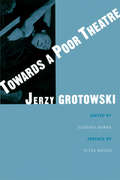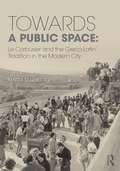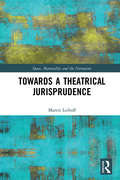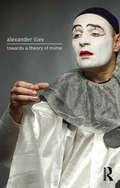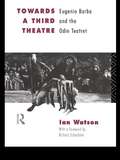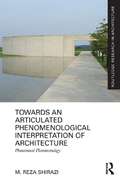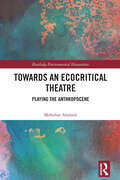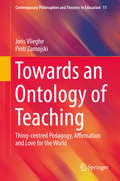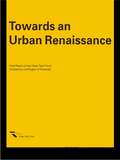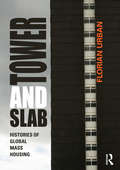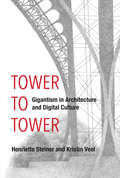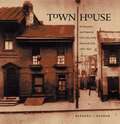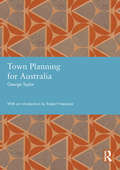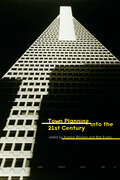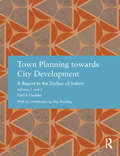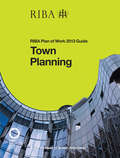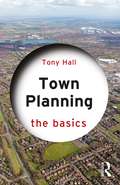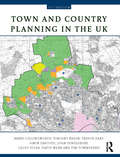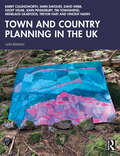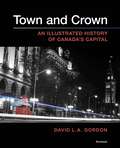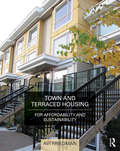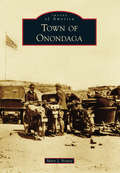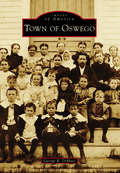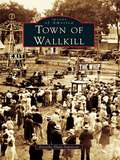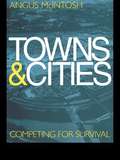- Table View
- List View
Towards a Poor Theatre (Eyre Methuen Dramabooks Ser.)
by Jerzy GrotowskiOriginally published in 1968, Jerzy Grotowski's groundbreaking book is available once again. As a record of Grotowski's theatrical experiments, this book is an invaluable resource to students and theater practioners alike.
Towards a Public Space: Le Corbusier and the Greco-Latin Tradition in the Modern City
by Marta SequeiraLe Corbusier is well-known for his architectural accomplishments, which have been extensively discussed in literature. Towards a Public Space instead offers a unique analysis of Le Corbusier’s contributions to urban planning. The public spaces in Le Corbusier’s plans are usually considered to break with the past and to have nothing whatsoever in common with the public spaces created before modernism. This view is fostered by both the innovative character of his proposals and by the proliferation in his manifestos of watchwords that mask any evocation of the past, like l’esprit nouveau ("new spirit") and l’architecture de demain ("architecture of tomorrow"). However, if we manage to rid ourselves of certain preconceived ideas, which underpin a somewhat less-than-objective idea of modernity, we find that Le Corbusier's public spaces not only didn't break with the historical past in any abrupt way but actually testified to the continuity of human creation over time. Aimed at academics and students in architecture, architectural history and urban planning, this book fills a gap in the systematic analysis of Le Corbusier’s city scale plans and, specifically, Corbusian public spaces following the Second World War.
Towards a Theatrical Jurisprudence
by Marett LeiboffThis book brings the insights of theatre theory to law, legal interpretation and the jurisprudential to reshape law as a practice of response and responsibility. Confronting a Baconian antitheatrical legality embedded in its jurisprudences and interpretative practices, Marett Leiboff turns to theatre theory and practice to ground a theatrical jurisprudence, taking its cues from Han-Thies Lehmann’s conception of the post-dramatic theatre and the early work of theatre visionary Jerzy Grotowski. She asks law to move beyond an imagined ideal grounded in Aristotelian drama and tragedy, and turns to the formation of the legal interpreter ・ lawyer, judge, jurisprudent ・ as fundamental to understanding what’s “noticed” or not noticed in law. We “notice” most easily through that which is written into the body of the legal interpreter, in a way that can’t be replicated through law’s standard practices of thinking and reasoning. Without more, thinking and reasoning are the epitome of antitheatricality legality; a set of theatrical antonyms, including transgression and instinct, offer instead a set of possibilities through which to reconceive assumptions and foundational concepts etched into the legal imaginary. And by turning to critical dramaturgy, the book reveals that the liveliness that sits behind theatrical jurisprudence isn’t a new concept in law at all, but has a long pedigree and lineage that had been lost and hidden. Theatrical jurisprudence, which demands an awareness of self and beyond self, grounds a responsiveness that can’t be found within doctrine, principle, or the technocratic, but also challenges us to notice what it is we think we know as well as what we know of lives in law that aren’t our own. The book will be of interest to scholars and students in the field of jurisprudence, legal theory, theatre and performance studies, cultural studies and philosophy.
Towards a Theory of Mime
by Alexander IlievTowards a Theory of Mime is a genuinely unique book about non-verbal communication and performance. Combining a broad global history of the evolution of human communication with an introduction to the general practice of mime, Alexander Iliev traces a lineage from Marceau and Barrault to his own distinguished practice as performer and teacher. The book moves from a fascinating description of the first principles of gestural language to a stunning sequence of specific exercises in practical training.Written in a sometimes poetic, always accessible and often humorous style, Towards a Theory of Mime conveys complex ideas in a strikingly accessible way.Alexander Iliev has over forty years experience practising and teaching both theatre and anthropology around the world. He is currently Associate Professor at the National Academy in Sofia.
Towards a Third Theatre: Eugenio Barba and the Odin Teatret
by Ian WatsonEugenio Barba is one of Europe's leading theatre directors, at the forefront of experimental and group theatre for more than twenty years. Ian Watson provides the most comprehensive and systematic study of Barba's work, including his training methods, dramaturgy, productions and theories, as well as his work at the International School of Theatre Anthropology.
Towards an Articulated Phenomenological Interpretation of Architecture: Phenomenal Phenomenology (Routledge Research in Architecture)
by M. Reza ShiraziThis book sheds light on the contemporary status of phenomenological discourse in architecture and investigates its current scholastic as well as practical position. Starting with a concise introduction to the philosophical grounds of phenomenology from the points of view of Husserl, Merleau-Ponty and Heidegger, it presents a critical reading of the works of some leading figures of architectural phenomenology in both theory and practice, such as Christian Norberg-Schultz, Kenneth Frampton, Juhani Pallasmaa, and Steven Holl. Highlighting the main challenges of the current phenomenological discourse in architecture, this book formulates a more articulated method of 'phenomenological interpretation' – dubbed 'phenomenal phenomenology' − as a new and innovative method of interpreting the built environment. Finally, using Tadao Ando's Langen Foundation Museum as a case study, it investigates the architect's contribution to phenomenological discourse, interprets and analyzes the Museum building using the new heuristic method, and thus provides a clear example of its applicability. By introducing a clear, articulated, and practical method of interpretation, this book is of interest to academics and students analyzing and studying architecture and the built environment at various scales.
Towards an Ecocritical Theatre: Playing the Anthropocene (Routledge Environmental Humanities)
by Mohebat AhmadiTowards an Ecocritical Theatre investigates contemporary theatre through the lens of Anthropocene-oriented ecocriticism. It assesses how Anthropocene thinking engages different modes of theatrical representation, as well as how the theatrical apparatus can rise to the representational challenges of changing interactions between humans and the nonhuman world. To explore these problems, the book investigates international Anglophone plays and performances by Caryl Churchill, Stephen Sewell, Andrew Bovell, E.M. Lewis, Chantal Bilodeau, Jordan Hall, and Miwa Matreyek, who have taken significant steps towards re-orienting theatre from its traditional focus on humans to an ecocritical attention to nonhumans and the environment in the Anthropocene. Their theatrical works show how an engagement with the problem of scale disrupts the humanist bias of theatre, provoking new modes of theatrical inquiry that envision a scale beyond the human and realign our ecological culture, art, and intimacy with geological time. Moreover, the plays and performances studied here, through their liveness, immediacy, physicality, and communality, examine such scalar shifts via the problem of agency in order to give expression to the stories of nonhuman actants. These theatrical works provoke reflections on the flourishing of multispecies responsibilities and sensitivities in aesthetic and ethical terms, providing a platform for research in the environmental humanities through imaginative conversations on the world’s iterative performativity in which all bodies, human and nonhuman, are cast horizontally as agential forces on the theatrical world stage. This book will be of great interest to students and scholars of theatre studies, environmental humanities, and ecocritical studies.
Towards an Ontology of Teaching: Thing-centred Pedagogy, Affirmation and Love for the World (Contemporary Philosophies and Theories in Education #11)
by Joris Vlieghe Piotr ZamojskiThis book opens an original and timely perspective on why it is we teach and want to pass on our world to the new generation. Teaching is presented in this book as a way of being, rather than as a matter of expertise, which is driven by love for a subject matter. With the help of philosophical thinkers such as Arendt, Badiou and Agamben, the authors articulate a fully positive account of education that goes beyond the critical approach, which has become prevailing in much contemporary educational theory, and which testifies to a hate of the world and to a confusion of what politics and education are about. Therefore, the authors develop the idea of a thing-centred pedagogy, as opposed to both teacher-centred and student-centred approaches. The authors furthermore illustrate their purely educational account of teaching by looking at the writing and the television performance of Leonard Bernstein who embodies what teaching out of love and care for a subject is all about. This book is of interest to all those concerned with fundamental and philosophical questions about education and to those interested in (music) education.
Towards an Urban Renaissance
by The Urban Task ForceThe Urban Task Force, headed by Lord Rogers, one of the UK's leading architects, was established by the Department of Environment, Transport and Regions (DETR) to stimulate debate about our urban environment and to identify ways of creating urban areas in direct response to people's needs and aspirations. Their findings, conclusions and recommendations were presented in a final report to Government Ministers in Summer 1999 and form the basis of this important new illustrated book.
Tower and Slab: Histories of Global Mass Housing
by Florian UrbanTower and Slab looks at the contradictory history of the modernist mass housing block - home to millions of city dwellers around the world. Few urban forms have roused as much controversy. While in the United States decades-long criticism caused the demolition of most mass housing projects for the poor, in the booming metropolises of Shanghai and Mumbai remarkably similar developments are being built for the wealthy middle class. While on the surface the modernist apartment block appears universal, it is in fact diverse in its significance and connotations as its many different cultural contexts. Florian Urban studies the history of mass housing in seven narratives: Chicago, Paris, Berlin, Brasilia, Mumbai, Moscow, and Shanghai. Investigating the complex interactions between city planning and social history, Tower and Slab shows how the modernist vision to house the masses in serial blocks succeeded in certain contexts and failed in others. Success and failure, in this respect, refers not only to the original goals – to solve the housing crisis and provide modern standards for the entire society – but equally to changing significance of the housing blocks within the respective societies and their perception by architects, politicians, and inhabitants. These differences show that design is not to blame for mass housing’s mixed record of success. The comparison of the apparently similar projects suggests that triumph or disaster does not depend on a single variable but rather on a complex formula that includes not only form, but also social composition, location within the city, effective maintenance, and a variety of cultural, social, and political factors.
Tower to Tower: Gigantism in Architecture and Digital Culture (The\mit Press Ser.)
by Henriette Steiner Kristin VeelA cultural history of gigantism in architecture and digital culture, from the Eiffel Tower to the World Trade Center.The gigantic is everywhere, and gigantism is manifest in everything from excessively tall skyscrapers to globe-spanning digital networks. In this book, Henriette Steiner and Kristin Veel map and critique the trajectory of gigantism in architecture and digital culture—the convergence of tall buildings and networked infrastructures—from the Eiffel Tower to One World Trade Center. They show how these two forms of gigantism intersect in the figure of the skyscraper with a transmitting antenna on its roof, a gigantic building that is also a nodal point in a gigantic digital infrastructure.Steiner and Veel focus on two paradigmatic tower sites: the Eiffel Tower and the Twin Towers of the destroyed World Trade Center (as well as their replacement, the One World Trade Center tower). They consider, among other things, philosophical interpretations of the Eiffel Tower; the design and destruction of the Twin Towers; the architectural debates surrounding the erection of One World Trade Center on the Ground Zero site; and such recent examples of gigantism across architecture and digital culture as Rem Koolhaas's headquarters for China Central TV and the phenomenon of the “tech giant.” Examining the cultural, architectural, and media history of these towers, they analyze the changing conceptions of the gigantism that they represent, not just as physical structures but as sites for the projection of cultural ideas and ideals.
Town House
by Bernard L. HermanIn this abundantly illustrated volume, Bernard Herman provides a history of urban dwellings and the people who built and lived in them in early America. In the eighteenth century, cities were constant objects of idealization, often viewed as the outward manifestations of an organized, civil society. As the physical objects that composed the largest portion of urban settings, town houses contained and signified different aspects of city life, argues Herman.Taking a material culture approach, Herman examines urban domestic buildings from Charleston, South Carolina, to Portsmouth, New Hampshire, as well as those in English cities and towns, to better understand why people built the houses they did and how their homes informed everyday city life. Working with buildings and documentary sources as diverse as court cases and recipes, Herman interprets town houses as lived experience. Chapters consider an array of domestic spaces, including the merchant family's house, the servant's quarter, and the widow's dower. Herman demonstrates that city houses served as sites of power as well as complex and often conflicted artifacts mapping the everyday negotiations of social identity and the display of sociability.
Town Planning for Australia (Studies in International Planning History)
by George TaylorGeorge Taylor's Town Planning for Australia was the first dedicated book on the subject of urban planning published in Australia. Journalistic and ideological in style, it sets out a robust vision for a specifically Australian approach to planning and development of towns in a young country. Taylor was a controversial figure, a political activist and publisher who brought the NSW Town Planning Association into existence and played a key role in publishing and promoting planning into the 1920s.His wife Florence Taylor was the first female qualified architect and trained engineer in Australia, and an important figure in the history of planning and publishing in Australia.
Town Planning into the 21st Century
by Bob Evans Andrew BlowersProvides a series of insights into the planning process, introduces the key issues currently facing planning and offers prescriptions for the changes required as we move into the next millenium. Leading experts outline the changing context for land use and environmental policy in Britain and explain why the existing processes and profession of town planning are likely to be unable to provide satisfactory policy responses in the future. Key themes debated include: * widening the remit of traditional town planning * giving land and buildings a community value * acting for people rather than simply for the market * promoting an equalization of environmental conditions and discouragement of motorization * the need to anticipate long term global trends at the local and national level. Contributors: Andrew Blowers, Bob Colenutt, Richard Cowell, Bob Evans, Cliff Hague, Peter Hall, Susan Owens, Eric Reade, Yvonne Rydin.
Town Planning towards City Development: A Report to the Durbar of Indore (Studies in International Planning History)
by Patrick GeddesPatrick Geddes is one of the most important figures in planning history, variously presented as an inspiration to regional planning, environmental planning and sustainability, grass-roots planning, citizen democracy, historic preservation, neighbourhood upgrading, university–community partnership, lifelong learning, and co-operative housing. Though well-known and often praised by planning historians, his scholarship extended across a much broader range of disciplines, with extensive publication on biology and on civics, and significant contributions to sociology, economics, geography, education, and the arts and humanities. With the exception of his plan of Dunfermline, published in 1904, his plans are very hard to find. Most of his plans were prepared in India between 1915 and 1923, but beyond brief extracts from four of them included by Jaqueline Tyrwhitt in the book Patrick Geddes in India, they are very difficult to obtain. Some are lost altogether and the remainder are available in a handful of libraries, often held in Archives. Of all the plans prepared after Dunfermline, the most extensive is for the city of Indore, originally published in two volumes that combine a comprehensive scheme for the urban development of the city with a detailed plan for the proposed University of Central India.
Town Planning: RIBA Plan of Work 2013 Guide
by Ruth ReedThe RIBA Plan of Work 2013 Guide: Design Management is part of a brand new series providing must-read practical guidance to running efficient and successful projects using the new RIBA Plan of Work 2013. Each guide takes a core project task – in this case those associated with planning - and explains the essential activities and considerations required at each stage of the new Plan of Work. Easy to use and navigate and in a small and handy format these guides will provide the ultimate quick reference support at your desk or on site. The author provides concise and pragmatic advice rooted in real world experience – a ‘how to’ that will resonate with practitioners. In-text features such as ‘hints and tips’, ‘checklists’, ‘forms and templates’ and ‘signposts’ to trusted resources will provide user-friendly support. Boxed examples will highlight best practice and illuminate common problems and solutions borne of hard won experience.
Town Planning: The Basics (The Basics)
by Tony HallThe planning of urban and rural areas requires thinking about where people will live, work, play, study, shop and how they will get about the place, and to devise strategies for long time periods. Town Planning: The Basics provides a general introduction to the components of urban areas, including housing, transportation and infrastructure, and health and environment, showing how appropriate policies can be developed. Explaining planning activity at different scales of operation, this book distinguishes between the "big stuff", the grand strategy for providing homes, jobs and infrastructure; the "medium stuff", the design and location of development; and the "small stuff" affecting mainly small sites and individual households. Planning as an activity is part of a complex web stretching way beyond the planning office, and this book provides an overview of the many components needed to create a successful town. It is invaluable to anyone with an interest in planning, from students learning about the subject for the first time to graduates thinking about embarking on a career in planning, to local councillors on planning committees and community boards.
Town and Country Planning in the UK
by David Webb Barry Cullingworth Geoff Vigar John Pendlebury Simin Davoudi Tim Townshend Trevor Hart Vincent NadinTown and country planning has never been more important to the UK, nor more prominent in national debate. Planning generates great controversy: whether it's spending £80m and four years' inquiry into Heathrow's Terminal 5, or the 200 proposed wind turbines in the Shetland Isles. On a smaller scale telecoms masts, take-aways, house extensions, and even fences are often the cause of local conflict. Town and Country Planning in the UK has been extensively revised by a new author group. This 15th Edition incorporates the major changes to planning introduced by the coalition government elected in 2010, particularly through the National Planning Policy Framework and associated practice guidance and the Localism Act. It provides a critical discussion of the systems of planning, the procedures for managing development and land use change, and the mechanisms for implementing policy and proposals. It reviews current policy for sustainable development and the associated economic, social and environmental themes relevant to planning in both urban and rural contexts. Contemporary arrangements are explained with reference to their historical development, the influence of the European Union, the roles of central and local government, and developing social and economic demands for land use change. Detailed consideration is given to * the nature of planning and its historical evolution * the role of the EU, central, regional and local government * mechanisms for developing policy, and managing these changes * policies for guiding and delivering housing and economic development * sustainable development principles for planning, including pollution control * the importance of design in planning * conserving the heritage * community engagement in planning The many recent changes to the system are explained in detail - the new national planning policy framework; the impact of the loss of the regional tier in planning and of the insertion of neighbourhood level planning; the transition from development control to development management; the continued and growing importance of environmental matters in planning; community engagement; partnership working; changes to planning gain and the introduction of the Community Infrastructure Levy; and new initiatives across a number of other themes. Notes on further reading are provided and at the end of the book there is an extensive bibliography, maintaining its reputation as the 'bible' of British planning.
Town and Country Planning in the UK
by Barry Cullingworth Simin Davoudi David Webb Geoff Vigar John Pendlebury Tim Townshend Menelaos Gkartzios Trevor Hart Vincent NadinTown and Country Planning in the UK provides one of the most authoritative and comprehensive accounts of British planning history, institutions, legislation, policies, processes and practices. This 16th edition has been substantially revised and re-organised to provide an up-to-date overview of the planning systems in the four nations of the UK, supported by analyses, interpretations, illustrations and examples from planning practice.The new edition features: details of the legislative and policy changes since 2015 and discussion of their implications, including the early stages of the Levelling Up and Regeneration Act, 2023 discussion of environmental policies and programmes and the impact of Brexit on environmental regulatory landscape in Britain changes to climate change and resilience policies, notably the government’s ‘Net Zero’ agenda and their implications for planning updates to the substantive issues in plan-making, especially the responses to the shortage of affordable housing and the development of major infrastructure changes to the processes involved in plan-making and development management an expanded and revised chapter on design to include the growing significance of public health in the built environment major revisions to the chapter on rural planning revisions of the text on planning theory especially in relation to management of conflicts over the use and development of land extended discussion of politics, professionalism and participation in planning The 16th edition of Town and Country Planning in the UK is an ideal starting point for those who are studying or working in the planning field, and for other professionals who need to locate their work in the planning context.
Town and Crown: An Illustrated History of Canada’s Capital
by David L. GordonTown and Crown is an illustrated history of the planning and development of Canada’s capital, filling a significant gap in our urban scholarship. It is the story of the transformation of the region from a subarctic wilderness portage to an attractive modern metropolis with a high quality of life. The book examines the period from 1800 to 2011 and is the first major study that covers both sides of the Ottawa River, addressing the settlement history of Aboriginal, French, and English peoples.Ottawa’s transformation was a significant Canadian achievement of the new profession of urban planning in the mid-20th century. Our national capital has the country’s most complete history of community planning and served as a gateway for important international planning ideas and designers. Town and Crown illustrates the influence of landscape architect and Olmsted protégé Frederick Todd, Chicago’s City Beautiful architect Edward Bennett, and British planner Thomas Adams. Prime Minister Mackenzie King maintained a direct interest in planning Canada’s capital for almost fifty years, choosing France’s leading urbaniste, Jacques Gréber, to plan the post-1945 redevelopment of the region.The principal research method for Town and Crown includes over sixteen years of archival studies in North America, Australia, and Europe, and interviews with key politicians, designers, and planners that supplemented the contemporary research. The narrative is supplemented by over 200 images drawn from early sketches, historical maps, plans, and archival photography to illustrate the physical transformation of Canada’s federal capital.
Town and Terraced Housing: For Affordability and Sustainability
by Avi FriedmanRecent societal changes have brought about renewed interest from architects, town planners, housing officials and the public in terraces and townhouses. The small footprint that this style of house occupies allows a sustainable high density approach to habitation, slowing sprawl and creating energy-efficient affordable living. Townhouses have been used for hundreds of years, and their evolution is covered from their inception right up to the present day. With the changing demographics of buyers in mind, Avi Friedman details how the design of these houses can be adapted to keep-up with contemporary needs. Friedman uses a systematic approach to cover the many facets of townhouses from interior design and construction methods, to urban planning issues like adjusting to the site’s natural conditions, street configurations and open spaces. This approach creates a book which will be a valuable resource for those involved in the planning, design and creation of terraced and town houses. Over 150 detailed diagrams and plans, and eighty photos, illustrate the essential elements of this style of housing. In the final chapter, lessons learnt throughout the book are draw together in ten broad ranging case study projects, showing how the various aspects can be put into practice.
Town of Onondaga
by Mary J. NowyjLocated in central New York, the town of Onondaga was incorporated in 1798 and currently consists of eight hamlets within a 65-mile radius. Each hamlet has contributed specifically to the town's rich history and development over the years. Originally part of the Onondaga and Salt Springs Reservations, the region was not part of the Military Tract of Central New York after the Revolutionary War. Individuals arrived for its farmlands, mills, quarries, salt production, and vast topography. A particularly fruitful crop in South Onondaga and Navarino is the apple. The first Onondaga County Courthouse was established here, as was the first county home for the poor. Onondaga Community College (OCC), built on a hilltop, has become an identifiable and highly respectable educational landmark in the town.
Town of Oswego
by George R. DemassThe town of Oswego, located on the shores of Lake Ontario, was established in 1818. It has played a vital role in Central New York's economy with its many fruit orchards, strawberries, and muckland crops of onions, lettuce, and potatoes. Oswego has been on the cutting edge of education and various social reforms. It was home to the first free public school in the area--a one-room schoolhouse on Bunker Hill Road--and today hosts most of the State University of New York at Oswego, founded as the first Normal School in the country. Dr. Mary Edwards Walker, the only woman to receive the Medal of Honor, pioneered women's suffrage and dress reform. Another famous resident, David Hall McConnell, founded the California Perfume Company, now known as Avon Products, Inc. The town of Oswego was and remains a vibrant community of families, many of whom have been there for generations.
Town of Wallkill
by Dorothy Hunt-IngrassiaTown of Wallkill chronicles the history of a town situated midway between two great rivers, the Hudson on the east and the Delaware on the west. It portrays the growth of this community, which was organized in 1772, from homesteads and farms, hamlets and schoolhouses, sawmills and gristmills, to trolleys and parks and beyond.
Towns and Cities: Competing for survival
by Angus McIntosh Dr Angus McintoshThe last fifty years have seen dramatic changes in towns and cities. People have moved out of central urban areas, retailing has moved out of towns and jobs have also declined in city centres, particularly with the growth of business and science parks. With the continuing decline of the manufacturing sector and the re-shaping of employment in the service sector, a new force will increasingly dominate urban development, the meritocratic elite. The meritocratic elite are those able to develop and use information technology to generate productivity and wealth. Where they wish to live will increasingly influence future urban development.Towns and Cities - Competing for survival suggests that as public and private corporations continue to downsize, outsource and re-engineer themselves, an increasing amount of expenditure and employment growth will lie with the leisure sector. Herein lies one of the solutions to the decline of towns and cities.Town planners and economists have continually displayed a lack of understanding of these developments and have not anticipated the forces which cause urban change. As the global econonmy, combined with changes in transport and information technology increasingly dominates our lives, local and national governments need a new agenda for the 21st century. If they fail to rise to this challenge many of our town and city centres will continue to decline and may not survive.
